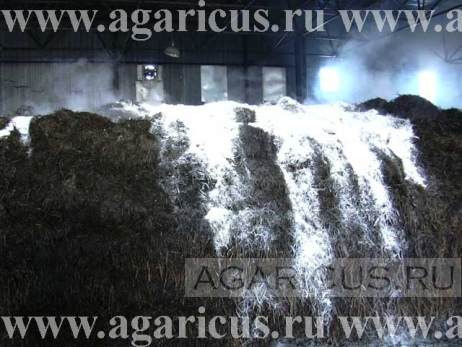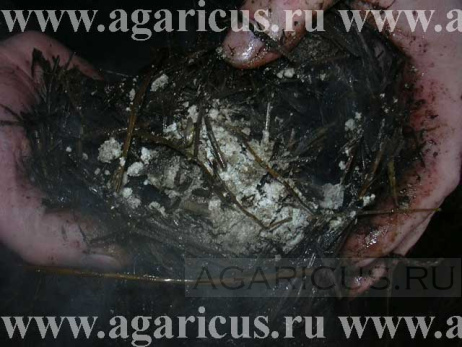Application and mixing of poultry manure with humid straw
The application of gypsum
In 1st phase compost preparation gypsum is used to improve the compost's structure, in order to regulate its pH level. At finalizing the technological process of 1st phase compost preparation, the compost yard's technologist should solve the following questions, concerning the use of gypsum. First Ц estimating the amount of applied gypsum to a ton of straw or a ton of compost. Second Ц determining in the process schedule of 1st phase compost preparation, the moment of gypsum application to the compost. And finally Ц deciding by which method will the gypsum be applied.
In literature on mushroom cultivation, it is usually recommended to use 60 kg of gypsum for a ton of piled straw. In real life, however, the raw materials components' quality doesn't always coincide with literary facts. Moreover, 1st phase is carried out differently in each compost yard: this depends on the technical abilities, the chosen compost preparation technology, and the drawn up schedule of works. And as a result, the amount of applied gypsum is greatly varies, from 20 to 90 kg for a ton of compost. In practice, a compost yard's technologist must determine an optimal amount of gypsum for a ton of straw considering the compost's pH level.
When is it better to apply gypsum? To answer this question, let's think a little bit. The gypsum and compost reaction processes need time, and the compost should be in a specific state of readiness, in order to react with gypsum. If, for example, the gypsum is applied in the end of the composting process, just before sending the compost to pasteurization, it won't do any good for the compost. There simply won't be enough time, and also, without gypsum, some irreversible and undesirable changes will take place in the compost. And if the gypsum is applied at compost filling, when there are no composting processes yet, the gypsum won't have anything to react with, so that is not a good option either. As the result of an examination of aforesaid, it can be conclude that it's best to apply gypsum when the compost is maximally active.
A wrong distribution of gypsum in the mass of compost
It's possible that this approach is very simplified and far from science, but the main thing is, that it brings positive results in practice for many years.
Gypsum can be applied however you like. But, it's important to remember, that gypsum should be distributed among the mass of compost as evenly as possible, escaping the formation of big clods of gypsum.



Lko:
Saheb hamare mushroom dry bable se pura form doob chuka hai ismein Ham Kya Karen Sahab Koi upay Ho to...
Production of Compost, Personal opinion (part 3). Wet...Abimbola Olaniyi-Balogun, Lagos Nigeria:
Hello there, I made mushroom compost using the long composting method. I used wet chicken manure, fresh...
Mushrooms in KazahstanZagreb, Croatia:
My name is Zlatko Vidmar.
Without chicken manure compost? Yes, it's possible...I am in modern mushroom growing over 40 years.
I see your farm and if...
nanyuki:
my email is samuelnjogo@gmail.com
Without chicken manure compost? Yes, it's possible...nanyuki:
i want to learn like a child on compost making for mushroom
Mushrooms in KazahstanVELLORE TAMILNADU INDIA:
SUITABLE JOBS Ц MUSHROOMS GROWER / COMPOST / SPAWN OR RELAVANT FIELDS
Without chicken manure compost? Yes, it's possible...Dear Hiring Manager...
Patna:
PLEASE SEND YOUR FORMULA without-chicken-manure-compost
watering first flush mushroomswasil, Malaysia:
i suggest you not to water on mush just maintain the good humidity if you not have any auto system for...
Compost Production. Personal opinion†(Part 2)NARENDER SEHRAWAT, FARIDABAD NCR:
COMMON PROBLEM IN PHASE 1 BUNKAR IS THE UNBALANCED TEMERATURE, IT STARTS FROM 50-55 DEGREES TO 78-82...
Without chicken manure compost? Yes, it's possible...Hannes, Plettenberg Bay, South Africa:
Can you give me more details on compost without chicken manure for mushroom growing, what alternatives...